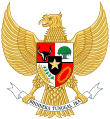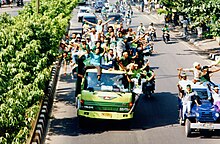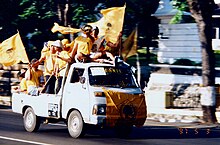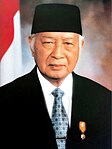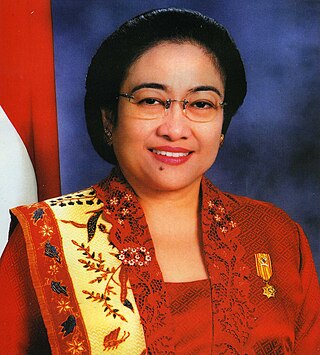
Diah Permata Megawati Setiawati Sukarnoputri is an Indonesian politician who served as the fifth president of Indonesia from 2001 to 2004. She previously served as the eighth vice president from 1999 to 2001.

Abdurrahman Wahid, though more colloquially known as Gus Dur, was an Indonesian politician and Islamic religious leader who served as the fourth president of Indonesia, from his election in 1999 until he was removed from office in 2001. A long time leader within the Nahdlatul Ulama organization, he was the founder of the National Awakening Party (PKB). He was the son of Minister of Religious Affairs Wahid Hasyim, and the grandson of Nahdatul Ulama founder Hasyim Asy'ari. Due to a visual impairment caused by glaucoma, he was blind in the left eye and partially blind in his right eye. He was the first president of Indonesia to have had physical disabilities.

The Indonesian Democratic Party of Struggle is a centre to centre-left secular-nationalist political party in Indonesia. Since 2014, it has been the ruling and largest party in the House of Representatives (DPR), having secured 128 seats in the last election. The party is led by Megawati Sukarnoputri, who served as the President of Indonesia from 2001 to 2004. It is also the party of the current president, Joko Widodo (Jokowi).
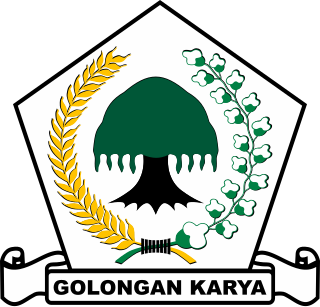
The Party of Functional Groups, often known by its abbreviation Golkar, is a centre-right big tent political party in Indonesia. It was founded as the Joint Secretariat of Functional Groups in 1964, and participated for the first time in national elections in 1971 as Functional Groups. Since 2019, it has been the second-largest party in the House of Representatives (DPR) with 85 seats. It is led by Airlangga Hartarto.

The United Development Party is an Islam-based political party in Indonesia. Due to its distinctive logo, the party is known as the "Kaaba Party".

Presidential elections were held in Indonesia on 5 July and 20 September 2004. As no candidate won a majority in the first round, a runoff was held, in which Susilo Bambang Yudhoyono defeated Megawati Sukarnoputri and was elected president. They were the first direct presidential elections in the history of Indonesia; prior to a 2002 amendment to the Constitution of Indonesia, both the president and vice president had been elected by the People's Consultative Assembly (MPR).

Elections in Indonesia have taken place since 1955 to elect a legislature. At a national level, Indonesian people did not elect a head of state – the president – until 2004. Since then, the president is elected for a five-year term, as are the 575-member People's Representative Council, the 136-seat Regional Representative Council, in addition to provincial and municipal legislative councils.

The Indonesian Democratic Party was one of the two state-approved parties during the New Order era of the late 20th-century in Indonesia.

Sudharmono, also known by his nickname, Pak Dar, was an Indonesian politician and army officer, who served as the fifth vice president of Indonesia, under the New Order regime of president Suharto, serving from 1988 until 1993. Previously, he served in several positions in the government and military, including as the Chairman of Golkar, State Secretary of Indonesia, and a Lieutenant General in the army.
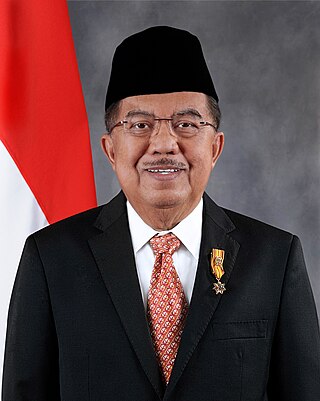
Muhammad Jusuf Kalla, commonly referred to by his initials JK, is an Indonesian politician and businessman who served as the 10th and 12th vice president of Indonesia, the only vice president in Indonesian history to serve two non-consecutive terms in office. He was unsuccessful as Golkar's presidential nominee in the 2009 presidential election. Before Kalla declared himself as the running mate for Joko Widodo in the 2014 presidential election, a 2012 poll placed his popularity among likely voters in the top three contenders for the presidency and ahead of his own party's nominee Aburizal Bakrie.

Presidential elections were held in Indonesia on 8 July 2009. The elections returned a president and vice president for the 2009–2014 term. Incumbent President Susilo Bambang Yudhoyono, elected with a 20% margin in the 2004 election, sought a second term against former President Megawati Sukarnoputri in a rematch of the 2004 election, as well as incumbent Vice President Jusuf Kalla. Securing a majority of the votes in a landslide victory in the first round, Yudhoyono was re-elected without the need to proceed to a second round, scheduled to be held on 8 September if no candidate received a majority of the popular vote. Yudhoyono was officially declared the victor of the election on 23 July 2009, by the General Election Commission (KPU). At the time of his re-election victory, Yudhoyono, with nearly 74 million votes in his favour, held the record for the highest number of votes for a single person in any democratic election in history, surpassing Barack Obama's total of 69.5 million votes in the 2008 United States presidential election. His record was surpassed by his respective successors Joko Widodo who won more than 85 million votes in 2019 and Prabowo Subianto who won more than 96 million votes in 2024.

Legislative elections were held in Indonesia on 3 July 1971, the first under the New Order regime. There were ten participants; nine political parties and the "functional group" Golkar, which came first with more than 60 percent of the vote, resulting in an absolute majority in the People's Representative Council.

Legislative elections were held in Indonesia on 2 May 1977. They were the third legislative elections since independence, and the second under the New Order regime. There were three participants; the two political parties and functional group Golkar.

Legislative elections were held in Indonesia on 4 May 1982. They were the fourth legislative elections since independence and the third under the New Order regime There were three participants; the two political parties, the United Development Party (PPP), the Indonesian Democratic Party (PDI) and the "functional group" Golkar. As with all elections during the New Order regime, the government-backed Golkar organization won an absolute majority.

Legislative elections were held in Indonesia on 23 April 1987, to elect 400 of the 500 members of the People's Representative Council (DPR), the national legislature. The election was the fifth legislative election in the country since independence and the fourth legislative election under President Suharto's New Order. The election resulted in an outright majority for Golkar, which retained its status as the ruling party of the country.
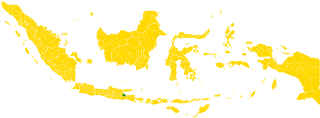
Legislative elections were held in Indonesia on 9 June 1992, to select 400 of the 500 members of the People's Representative Council (DPR). The election was the sixth legislative elections since Indonesian independence and the fifth legislative elections under the New Order regime of president Suharto. The election resulted in a clear victory for Golkar, which retained its status as the ruling party, although the opposition, under the United Development Party (PPP) and the Indonesian Democratic Party (PDI), saw their vote shares rise.

Early legislative elections were held in Indonesia on 7 June 1999. They were the first elections since the fall of Suharto and end of the New Order, the first free elections in Indonesia since 1955, and the first and only legislative election taken by East Timor during Indonesian provincehood. With the ending of restrictions on political activity following the fall of Suharto, a total of 48 parties contested the 462 seats up for election in the People's Representative Council. A further 38 seats were reserved for members of the armed forces.
The 27 July Incident was an attack by Indonesian government forces on the head office of the Indonesian Democratic Party, which was being occupied by supporters of recently ousted party leader Megawati Sukarnoputri. It was followed by two days of riots in Jakarta.

The Onward Indonesia Coalition is an official political coalition in Indonesia that supported the presidential/vice presidential candidates Joko Widodo and Ma'ruf Amin in the 2019 presidential election. It was initially known as the Working Indonesia Coalition, founded in 2018. The coalition is currently utilized as the government of President Joko Widodo.

The Indonesian Democratic Union Party,, was a political party founded by Sri Bintang Pamungkas in 1995 and one of the political parties in Indonesia that participated in the 1999 general elections.
